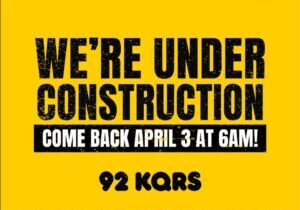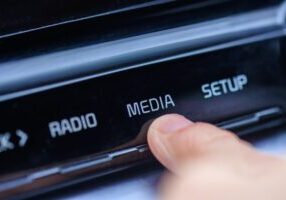
Last week’s post, “What’s Goin’ On (On The Radio?),” asked you to consider how differently consumers listened to the radio back in the day. When there were fewer distractions – and a lot less media – we were listening differently – more attentively – to everything: music, personalities, even commercials. In contrast, today it is much more challenging to make an impression, much less create perceptions and build brands.
Here in the “swing state” of Michigan where I live, we citizens have been pounded by political advertising, notably on television, with force and repetition unlike anything we’ve experienced before. It will be fascinating to see how the pundits will analyze the results of the presidential race after this TV ad assault. Both sides will probably tell us it now requires even more extreme levels of advertising fire power to drive home a win.
Decades ago, media reach was much different. In radio, we didn’t sweat distribution – we owned it. Every home in America had multiple radios, placed all over the house. Most owned a transistor radio in the ’60s, and a Walkman in the ’70s and ’80s so we could take our favorite radio stations with us anywhere. And radio was the undisputed king of the car. Every vehicle had an AM/FM radio – standard – in the center of the dashboard, accompanied only by an 8-track, cassette deck, or CD player. Those preset pushbuttons were the currency back then, a simple technology any driver could master to easily navigate up and down the radio dial.
Bottom line: Back then, if your station was passable, you did just fine. If it was stellar, you reaped in immense profits at obscene margins.
It’s hard to even imagine this scenario today, especially for radio people who have entered the business in the 2000s. The environment has constantly been crowded and competitive, forcing most radio companies to play defense against the onslaught of audio and video players vying for attention and share.
As we’ve seen consistently in our Techsurveys these past 20 years, first it was the iPod and then the smartphone that signaled the demise of the portable radio. Led by the iPhone, smartphones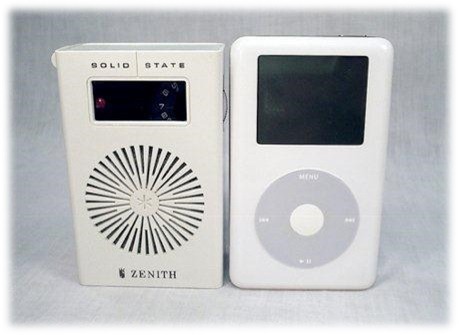 proliferated to a point where now well more than 90% of us have one (according to all three of our Techsurveys). Not only have they become ubiquitous, the ability to carry the Internet around with us 24/7 makes our phones our most prized possessions.
proliferated to a point where now well more than 90% of us have one (according to all three of our Techsurveys). Not only have they become ubiquitous, the ability to carry the Internet around with us 24/7 makes our phones our most prized possessions.
As my team learned back in 2008 when we launched jacapps – about 100 days after Apple opened their now-famous App Store – mobile apps were to become a key conduit to listening to broadcast radio in the Digital Age, especially as conventional radios began to disappear from homes, workplaces, and you name it. Just try to buy one now.
 But as I’ve long maintained, the ability to listen to an AM or FM station on a mobile device is a gift. Smartphone and tablets – and their apps – restored radio’s portability. If a station’s content is competitive and it is meeting the audience where they are, radio can not only survive, but even thrive even in this hyper-competitive environment.
But as I’ve long maintained, the ability to listen to an AM or FM station on a mobile device is a gift. Smartphone and tablets – and their apps – restored radio’s portability. If a station’s content is competitive and it is meeting the audience where they are, radio can not only survive, but even thrive even in this hyper-competitive environment.
And the app experience does not have to be limited to just listening to the stream. Smart stations are engaging their audiences in other ways with mobile apps. Public and Christian stations, in particular, are making good use of app donation features. In the Christian space, inspirational thoughts of the day are also available via mobile wherever and whenever listeners need a spiritual boost the most.
We just wrapped up our eleventh annual Christian Music Broadcasters version of Techsurvey last week. Let me show you a couple key data points.
First, more and more listeners tell us their favorite Christian music station has their own app and they’ve downloaded it.
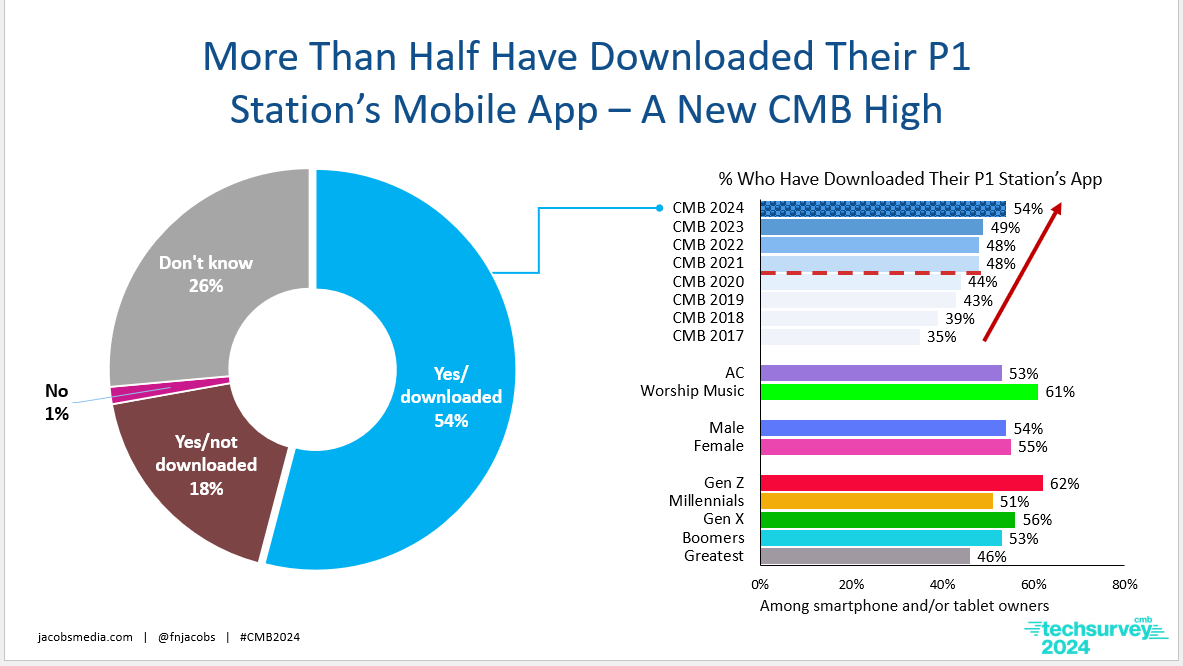
The trending (upper right) tells an incredible post-pandemic story we see across all our Techsurveys. Being isolated at home during COVID appeared to motivate many core listeners to download their favorite station’s app – especially in situations where there was no working radio at home. When a majority of your station’s most important listeners has placed your app on their mobile device, that’s when the magic happens. It’s like you’re one of their dashboard presets, except this time a radio station is on the one device they take everywhere – including to bed.
We asked these same listeners to rate a series of app “use cases” and for Christian music radio, there are important takeaways here that can have high brand impact:
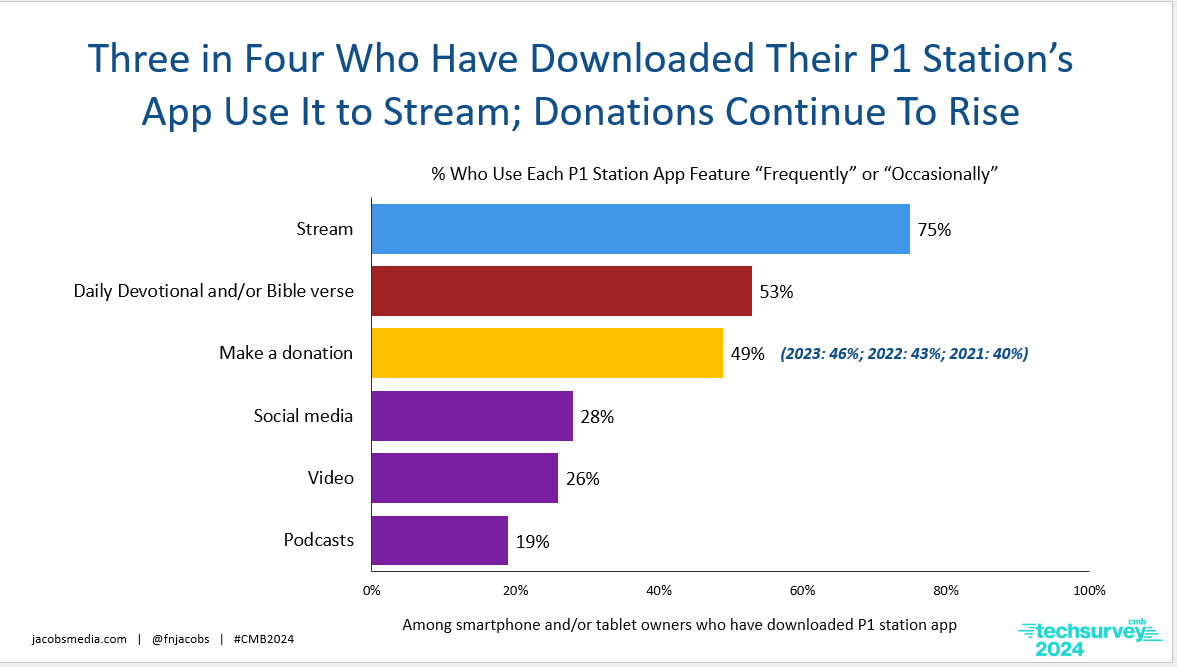
For those of you with your own station app, that high use of the app to stream your programming content won’t surprise you. But for these Christian music stations, the daily devotional and donation features are both at impressive levels. Particularly, using the app to make a financial contribution has been on the rise for the past several years. Imagine what happens when stations make a point to promote that convenient feature on their air, their website, and in other high-traffic places.
So, the big takeaway isn’t just the continued popularity of branded apps for radio, but the secondary and tertiary features that can make audience members happy. There’s no estimating the importance of brand satisfaction, and in the case of mobile apps, it’s not all that difficult to achieve.

To wit, an astounding 74% of these Christian music radio fans give their favorite stations’ apps an “excellent” score, also an all-time high for our Techsurveys. That level of appreciation for a station mobile app is simply off the charts.
All this is part of a burgeoning trend we’re seeing among consumer brands making a concerted effort to design branded apps that not only reflect their company and brand values but also bring satisfaction and joy to their customers.
In tomorrow’s JacoBLOG, I’ll show you an example of how one of the biggest and most popular brands in the U.S. is about to unveil a new mobile app loaded with surprises and unique engagement features. The new app’s goals are very different than what you usually see from retail companies.
But that’s the point – strong radio brands have the ability to do so much more with their mobile efforts.
What could your mobile app do for you?
For more info about mobile apps, check in with Bob Kernen at jacapps, or contact your own mobile app provider to have a conversation. – FJ
Originally published by Jacobs Media
